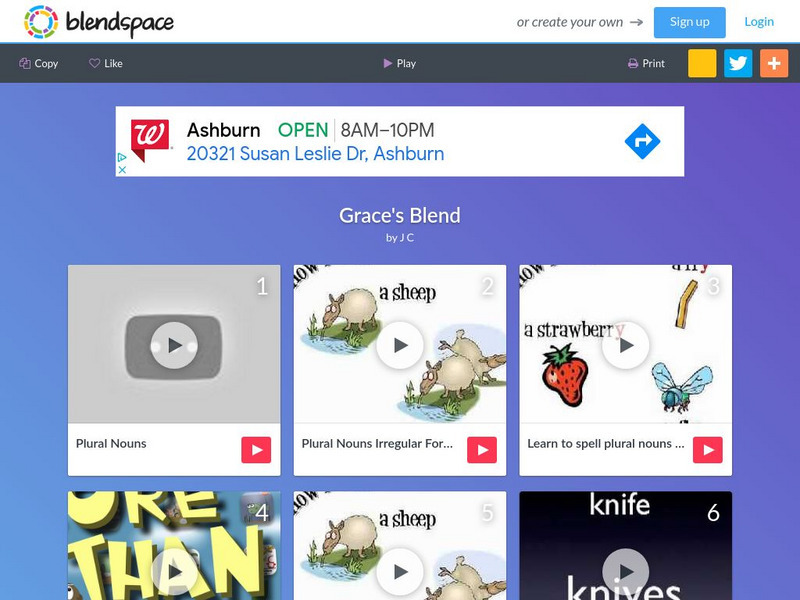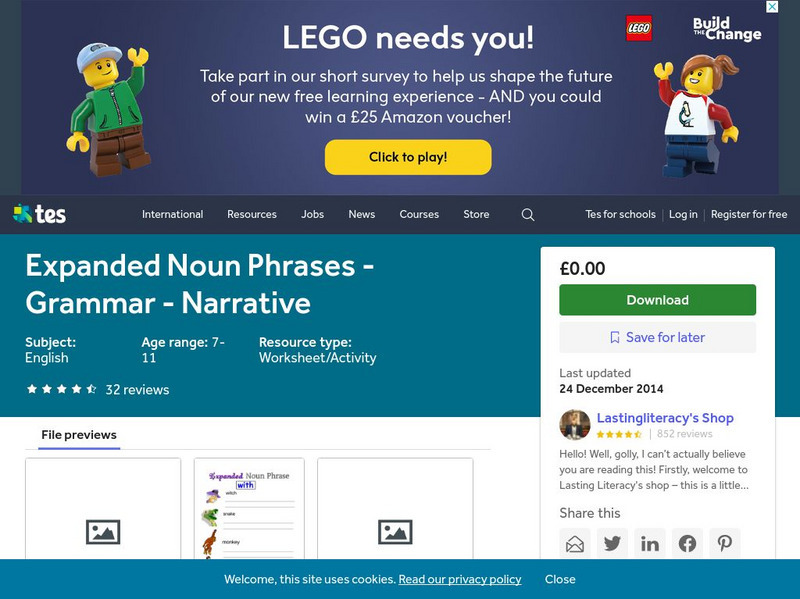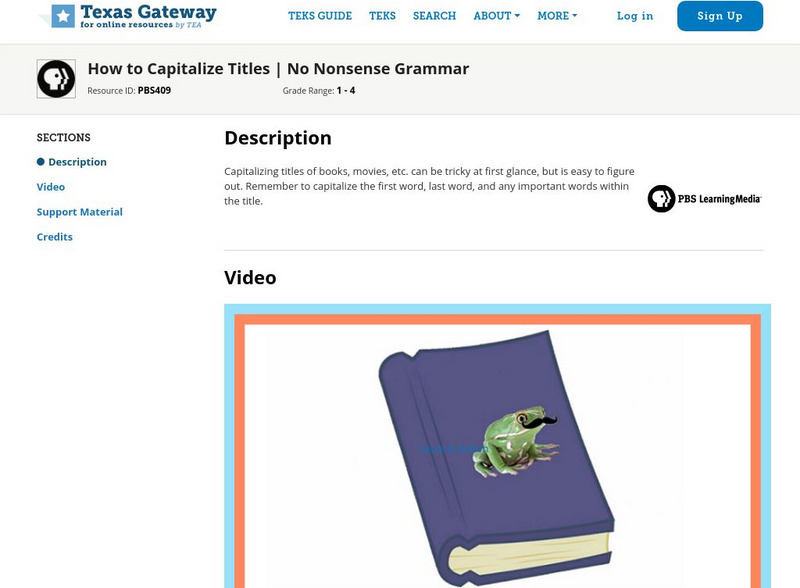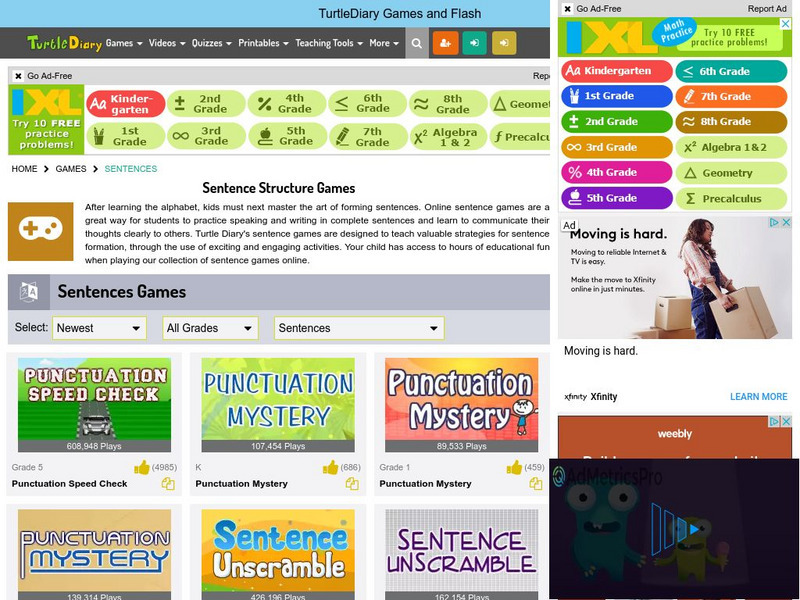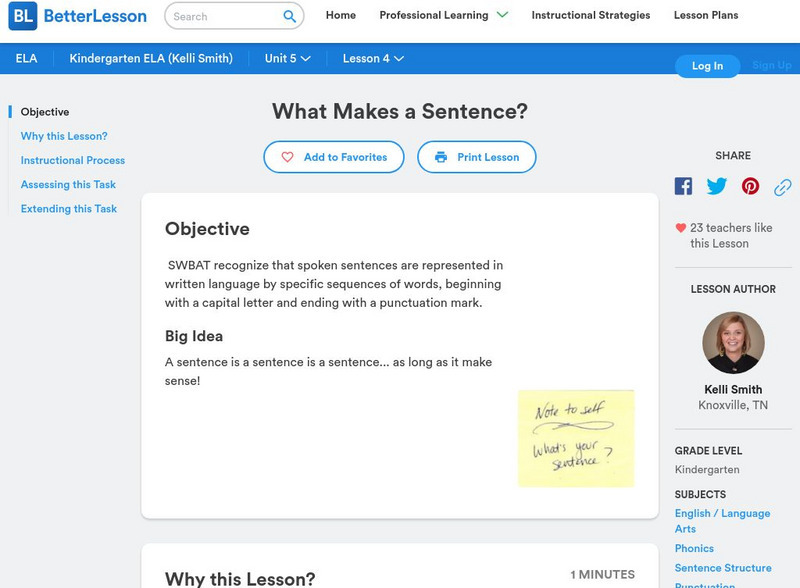Roy the Zebra
Roy the Zebra: The Big Full Stop Tidy Up [Pdf]
Learners will help Roy the Zebra learn about the "period" as a way to end complete sentences. Students will look at various pictures and then add periods to their related sentences. Then the learners will construct their own sentences...
TES Global
Blendspace: Grace's Blend
This fourteen-part learning module provides assorted activities for nouns. This blendspace provides reproducible resources, including video lessons and worksheets, for possessive nouns, plural nouns, possessive nouns, concrete nouns, and...
TES Global
Tes: Expanded Noun Phrases Grammar Narrative
[Free Registration/Login Required] This activity gives students the opportunity to add a prepositional phrase to a noun. In this activity, students will use the preposition "with" to begin the elaborative phrase for each provided noun.
Grammarly
Grammarly Blog: Comma
This page focuses on comma use; it explains the importance of the comma and provides an example of how drastically a comma can change the meaning of a sentence. It also provides links to 38 different pages of comma rules and examples.
ClassFlow
Class Flow: Chunk Lesson Each
[Free Registration/Login Required] Use literature and the Whole-Part-Whole Method to teach individual word chunks. This flipchart focuses on the -each word chunk.
ClassFlow
Class Flow: Chunk Lesson Et
[Free Registration/Login Required] Use literature and the Whole-Part-Whole Method to teach individual word chunks. This flipchart focuses on the -et word chunk.
ClassFlow
Class Flow: Chunk Lesson Ew
[Free Registration/Login Required] Use literature and the Whole-Part-Whole Method to teach individual word chunks. This flipchart focuses on the -ew word chunk.
ClassFlow
Class Flow: Chunk Lesson Ide
[Free Registration/Login Required] Use literature and the Whole-Part-Whole Method to teach individual word chunks. This flipchart focuses on the -ide word chunk.
ClassFlow
Class Flow: Chunk Lesson In
[Free Registration/Login Required] Use literature and the Whole-Part-Whole Method to teach individual word chunks. This flipchart focuses on the -in word chunk.
ClassFlow
Class Flow: Chunk Lesson Out
[Free Registration/Login Required] Use literature and the Whole-Part-Whole Method to teach individual word chunks. This flipchart focuses on the -out word chunk.
Other
English Grammar Revolution: Types of Sentences
This site offers a brief tutorial on the four types of sentences, then two exercises of 10 sentences each, for student practice or assessment. Answers are also available.
ClassFlow
Class Flow: Chunk Lesson Am
[Free Registration/Login Required] Use literature and the Whole-Part-Whole Method to teach individual word chunks. This flipchart focuses on the -am word chunk.
ClassFlow
Class Flow: Chunk Lesson An
[Free Registration/Login Required] Use literature and the Whole-Part-Whole Method to teach individual word chunks. This flipchart focuses on the -an word chunk.
ClassFlow
Class Flow: Chunk Lesson Ar
[Free Registration/Login Required] Use literature and the Whole-Part-Whole Method to teach individual word chunks. This flipchart focuses on the --ar word chunk.
English Worksheets Land
English Worksheets Land: Using Commas in Dates and With Single Words
Eight printable worksheets about using commas in a series, and seven printable worksheets about using commas in dates are available with answer keys.
Other
Tls Books: Letter From San Diego [Pdf]
A printable activity for students to practice their skill in using commas and capital letters.
Texas Education Agency
Texas Gateway: How to Capitalize Titles | No Nonsense Grammar
Capitalizing titles of books, movies, etc. can be tricky at first glance, but is easy to figure out. Remember to capitalize the first word, last word, and any important words within the title.
PBS
Pbs: No Nonsense Grammar: Using Proper Punctuation for Titles
This video focuses on correctly punctuating titles. Small works (short stories, essays, magazine and newspaper articles, etc.) are indicated with the use of quotation marks. Larger works, such as books or movies, are indicated either...
Turtle Diary
Turtle Diary: Sentence Structure Games
A collection of games for students to work on forming sentences. These games give students strategies for sentence formation.
Florida Center for Reading Research
Florida Center for Reading Research: Sentence Meaning: Silly Sentence Mix Up
A lesson plan in which students use sentence strips with various phrases to create sentences. Materials are included.
Love To Know Media
Your Dictionary: 2nd Grade Lesson Plans for Forming Possessives
This article focuses on teaching 2nd graders to form possessive. It provides two complete lesson plans with activities for teaching them how to form possessives.
Better Lesson
Better Lesson: Email Clarifying Questions
At the end of this lesson, students will demonstrate the use of commas, clarifying questions, and a friendly letter format by sending an email. Email is part of student's lives, and it is part of the digital landscape they will need to...
Big Learners
Biglearners.com: ccss.ela literacy.l.2.1.f : Second Grade English Language Arts
Here is a collection of our common core aligned worksheets for core standard L.2.1.F. A brief description of the worksheets is on each of the worksheet widgets. Click on the images to view, download, or print them. All worksheets are...
Better Lesson
Better Lesson: What Makes a Sentence?
This lesson will help students recognize that spoken sentences are represented in written language by specific sequences of words, beginning with a capital letter and ending with a punctuation mark. This lesson is short but it allows...


![Roy the Zebra: The Big Full Stop Tidy Up [Pdf] Unknown Type Roy the Zebra: The Big Full Stop Tidy Up [Pdf] Unknown Type](https://d15y2dacu3jp90.cloudfront.net/images/attachment_defaults/resource/large/FPO-knovation.png)
